Enjoy the sound of silence
Harnessing the power of the wind makes sailing an unforgettable experience. All you want to hear is the sound of the wind blowing and the waves breaking. But what is the best way to power the on-board electronics while the engine and generator are switched off? Victron combines energy storage and solar generation to provide the power you need. In absolute silence.
Whether you’re sailing away for the weekend or planning a trip around the world, big chance the very same Victron solution could support both. It’s the level of comfort that really determines your optimal solution aboard. With Victron you can power just about any plans, but as an example we illustrated ‘normal’ and ‘heavier’ power profiles in the below for the ‘average’ sailing yacht.
Let's take a look at your Optimal Energy Plan.
Consumption
How much do you need?
A modern sailing yacht is packed with a lot of electrical equipment. Most things used to run the boat usually use DC, bigger (household) appliances need AC. When it comes to estimating power consumption, many just add up the Watts. Time is equally important. A microwave might use 1000 Watts, but only for 2 minutes. A fridge might consume as little as 50 Watts, but is turned on 24 hours a day.
For inspirational purposes we’ve outlined 2 system examples based on ‘normal’ and ‘heavier’ use.
Example 1
The microwave uses 1000W an hour but is only on for 2 minutes a day.
1000W / 60 x 2 = 0.03 kWh / 2 minutes
Example 2
The fridge uses 50W an hour but is on the entire day (actually cooling ½ the day).
50W x 24hrs/2 = 0.6 kWh / day
Storage & conversion
How much energy should be stored?
Storing energy allows you to live of shorepower at sea or lets you use solar power harvested during the day over night. The inverter will convert the stored power to 230V. Sailing yachts typically experience long intervals between battery recharges, so your house battery should have a generous capacity. As a rule of thumb, we’re calculating with 48 hrs on board without shore power shore/engine/generator/solar power. Multiply the daily power consumption x days for even greater independency.
x 2
The storage capacity of a lithium battery should be two times the daily power consumption.
x 4
Due to its ±50% smaller discharge capacity, the storage capacity of a lead-acid battery should be four times the daily power consumption.
Conversion
The inverter should be sized to handle the average load continuously and should match the expected peak power current, which our inverters handle very well (on average 2 x their continuous current).
Generation
Where does the power come from?
Sources of power
Power profile


Normal and heavier power profiles in kWh, based on the daily energy consumption, which should be in balance with the generation.
Storage batteries in Ah, double the capacity using lead-acid batteries.
System diagram
for a lithium and lead-acid battery based system
How do the system design considerations translate into a robust system?

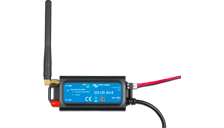
GX 4G modules
A GX 4G module will add mobile internet connectivity to your Victron Energy system. When your system is in range of a 4G network, it will send data to the VRM website and you can monitor the system from your smartphone. The module adds GPS tracking, recording your trips and putting up a geo-fence around the installation. You will get an alert via mail when the system travels outside the geo-fence area.
Victron Energy offers multiple 4G modules and the Global Link 520 modem, which operates without any monthly fees or subscriptions, for the first five years and several 4G modules. See our 4G Modems See our Global Link 520

The professionals choice:
See which of our Battery Monitors is recommended for this system example

AC devices
You’ll want to bring small devices on board for your trip. Or use household appliances like a microwave. These usually run of an AC outlet. Think of:
- Phone charger
- Laptop
- Television
- Refrigerator
- Microwave
Being able to plug-in these device saves you the trouble of finding a DC version.


Boat engines
Sailing yachts have one or two diesel engines (Catamarans) to get from harbour to horizon. The engines come with alternators to charge the engine batteries, drive fuel pumps, etc.
Once the starter batteries are recharged, the engines can also power the boat electrics and recharge the house battery. On bigger yachts you’ll find power hungry DC equipment such as anchor windlasses and bow thrusters. The engines have to be running before you can use them.

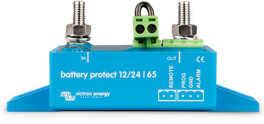
BatteryProtect
Discharging your battery too far will damage it. Adding a Victron BatteryProtect will disconnect the boat’s electronics when the battery voltage drops below a pre-set level. It will also automatically reconnect everything when the battery is sufficiently recharged.
There is more to a Victron BatteryProtect. The built-in shutdown delay ensures that vital electronics aren’t disconnected in error, i.e. when starting the engine causes a short drop in battery voltage.

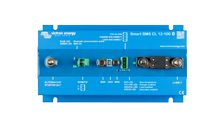
Battery Management Systems
Battery management systems take excellent care of Lithium batteries, protecting the individual cells of LiFePO4 batteries against over voltage, under voltage and over temperature and will shut down or reduce charging (VE.Bus products only) or disconnect the loads when this occurs.
Victron Energy offers several BMS options, in general the VE.Bus BMS and smallBMS signal separate devices to disconnect the charging (Inverter/Chargers, Cyrix-Li, DC-DC chargers) or disconnect the loads (BatteryProtect, Inverter/Charger), the modular Lynx distribution system features the Lynx BMS and other modules for more control over the DC busbar. For vehicles and boats all-in-one functionalities are available in the Smart BMS versions for Victron Lithium batteries, but also include current limiting to protect the alternator from overheating and BatteryProtect-like functionality to shut down the loads when pre-set critical battery conditions are met.
Victron Energy also offers full flexibility when it comes to selecting a third-party off-grid battery bank (and their BMS) of choice. A large number of well supported Lithium battery manufacturers can be easily integrated through the use of a mandatory GX-device. This flexibility enables our customers to perfectly match their off-grid needs for their unique power situation. When working with unsupported brands, a Victron Energy Battery Monitor is required to pass on accurate state of charge readings to the wider system.
See all our Battery Management Systems
The professionals choice:
See which product is recommended for this system example
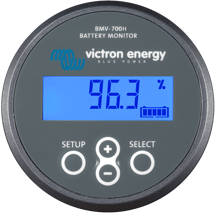
Battery Monitors
A battery monitor is like a "fuel gauge" for your battery. It records how much power is consumed and charged. The battery monitor calculates the state of charge, remaining capacity and time till empty. The battery voltage does not give an accurate indication of how full the battery is (especially not under load). A battery monitor does.
Victron Energy battery monitors keep track of historical data, like the number of charging cycles, deepest discharge, highest voltage, lowest voltage and so on. It will alert you to critical conditions such as low voltage or low charge and can even shut down the entire power supply to avoid expensive battery damage, or start a generator.
Victron offers battery monitors with or without display, Smart versions allow you to track the detailed data and adjust settings in our free VictronConnect app.
Most Lithium systems require a Battery Management System, which can feed battery information to the wider system. In this route a Battery Monitor might become redundant. See Battery Management System for more information. See all our Battery Monitors

The professionals choice:
See which of our Battery Monitors is recommended for this system example
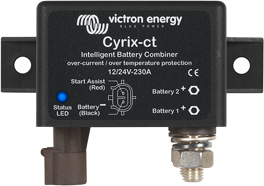
BatteryCombiner
The Cyrix BatteryCombiner is the only safe way to connect the house battery to the starter battery (to start your boat’s engines). With a BatteryCombiner you can charge the house battery from the alternator without running the risk of draining the starter battery (which always should be ready to go). When other sources of power are available (eg. shore/solar/generator power), the Cyrix BatteryCombiner will allow bi-directional charging from the house battery to the starter battery.
When the Voltages of the starter and house batteries are the same, use a Cyrix: its current rating should be equal or bigger than the current rating of the alternator. If the house battery is Lithium and the alternators Amperage is smaller than the house battery, or when the Voltages of the starter and house battery are different: use a Orion or Buck-Boost.


Boat Network
Keeping grips on all the systems on board can be a hassle. The solution: tie everything together in a single boat network using NMEA communication standards. Your boat network can include navigation equipment, tank senders, battery monitoring and much more. The status information can trigger alarms and shutdowns, adding to the safety on board. The Cerbo GX now supports the NMEA2000 out protocol, allowing you to monitor your boat’s network of systems from wherever you are.

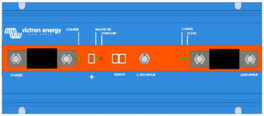
BMS 12/200
The BMS 12/200 is a dedicated battery management system (BMS) that protects Victron Smart 12,8V LFP batteries against deep discharges, overcharging and high temperatures with up to 200 Amps maximum DC current. When critical values are exceeded, the BMS acts immediately: loads are disconnected physically in case of a deep discharge and charging is stopped when there is a risk of overcharging. High temperatures trigger an immediate end to both charging and discharging.
This is the only BMS that can be directly connected to an alternator, protecting them from overload/overheating. This works with a combination of an AB fuse (rated in accordance with the expected max load current of the alternator) and an internal programmable input (which limits the input current electronically to 80% of the AB fuse).
Please check your manufacturer for the maximum charging current of your alternator and size AB fuses of the BMS 12/200 accordingly, see manual.
When different Lithium batteries & higher voltages are used, other solutions are needed, such as the VE.bus BMS and Lynx Ion BMS.
See our bigger boat types to see a bigger Lithium system and BMS See more info on alternator charging Lithium (and not blow them up)

Boat Electronics
A sailing yacht is home to several electronic devices. These are all connected to the house battery. Think of:
- Boat control panel
- Log/depth sounder
- Chart-plotter or GPS
- Navtex
- Auto pilot
- VHF Radio
- Navigation lights
- Pumps
- Windlass
- Bow thruster
- Fridge
- Interior lighting
- Music player

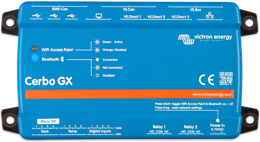
Cerbo GX
The Victron Cerbo GX is the communication-centre of your boat’s installation, allowing you to always have perfect control from wherever you are and maximises its performance. Simply connect through our Victron Remote Management (VRM) portal, or access directly, using the optional GX Touch 50 screen, a Multi Functional Display or our VictronConnect app thanks to its added Bluetooth capability.
The Victron Cerbo GX is an easy to use visual system. Instantly monitor the battery state of charge, power consumption, power harvest from PV, generator, and mains, or check tank levels and temperature measurements. Easily control the shore power input current limit, (auto)start/stop generator(s) or even set quiet periods to avoid starting the generator in the middle of the night. Change any setting to optimise the system, follow up on alerts, perform diagnostic checks and resolve challenges remotely. The Cerbo GX turns any power challenge into an effortless experience.

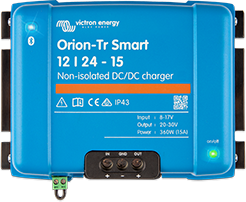
DC-DC chargers
DC-DC converters, or battery-to-battery chargers (converters with built-in charge algorithms) are used in dual battery systems, where the (smart) alternator and the start battery are combined with the service battery (of equal or different voltages) to charge it. They can also be used to charge applications that have dedicated batteries (eg. bow thrusters), or to power applications that have a voltage different than the service battery bank.
Most DC-DC chargers can be used in 12V or 24V systems and all are suitable for both lead acid and lithium batteries. Some DC-DC charger models can be parallel connected to increase the output current. DC-DC chargers are a perfect and safe solution to charge Lithium battery banks from smart alternators (and lead-acid batteries for that matter).
Charging lithium batteries from the alternator
Most alternators cannot be directly connected to lithium batteries. A lithium battery will draw more current than the alternator can supply, which may result in permanent alternator damage. To not damage the alternator, current limiting is one of the options to stay within the safe zone of the alternator.
Victron offers multiple solutions to solve this problem, of which one of them are the DC-DC converters:
- DC-DC converters act as a current limiter between the alternator and the battery: the battery can be safely charged without blowing up the alternator.
- Victron also offers alternative solutions for dual battery systems powered by alternators. Some (smart) BMS products physically limit the current drawn from the alternator, in other systems, battery combiners might be a solid option. See the datasheets for more info.

The professionals choice:
See which of our DC-DC chargers is recommended for this system example
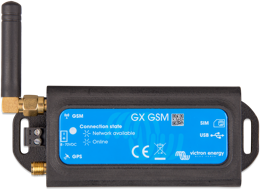
GX GSM Dongle
The Victron GX GSM is a 3G cellular modem that enables GX devices with mobile internet for the system and connection to the VRM Portal, allowing you to monitor your system from remote. When the boat is in range of a 3G network, it will send data to the VRM website and you can monitor the boat from your smartphone. The GSM module adds tracking the boat, recording your trips and putting up a geo-fence around the boat. You will get an alert via mail when the boat travels outside the geo-fence area.

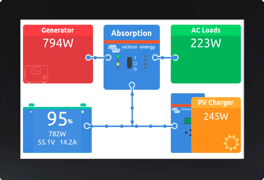
GX Touch
The Victron Energy Cerbo GX is the communication-centre of your systems installation, allowing you to always have perfect control from wherever you are and maximises its performance. The optional GX Touch 50 is a companion to the Cerbo GX, it’s five inch touch screen display gives an instant overview of your system and allows you to adjust settings in the blink of an eye.
Instantly monitor the battery state of charge, power consumption, power harvest from PV, generator, and mains, or check tank levels and temperature measurements. Easily control the shore power input current limit, (auto)start/stop generator(s) or even set quiet periods to avoid starting the generator in the middle of the night. Change any setting to optimise the system, follow up on alerts, perform diagnostic checks and resolve challenges remotely with the free Victron Remote Management (VRM) portal.
The Cerbo GX is an easy to use visual system and turns any power challenge into an effortless experience. Simply connect through our Victron Remote Management (VRM) portal, or access directly, using the optional GX Touch 50 screen, a Multi Functional Display or our VictronConnect app thanks to its added Bluetooth capability.

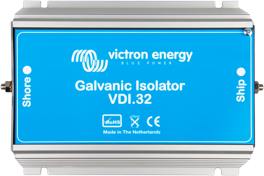
Galvanic Isolator
A galvanic isolator prevents electrolytic corrosion. The isolator is mounted directly behind the shore power connector on board. It blocks DC currents that might leak through the shore power earth terminal. These currents can cause corrosion to all metal parts under water, like the hull, propeller, shaft, etc. The galvanic isolator should have the same power rating as the incoming shore power.
It’s a misunderstanding that galvanic corrosion occurs only in metal and aluminium hulls. In fact it can occur on any boat as soon as a metallic part (the shaft and propeller) is in contact with water. Galvanic corrosion will quickly dissolve your sacrificial anodes, and attack the shaft, propeller and other metal parts in contact with water as soon as the boat is connected to the shore-side supply. It might therefore be tempting not to connect the ground conductor: this is however extremely dangerous because Ground Fault Current Interrupters will not work nor will a fuse blow in case of a short circuit to a metal part on the boat.
The safe option is to use a Galvanic Isolator for non-metal smaller boats, or use an isolation transformer for metal boats or boats with bigger systems.

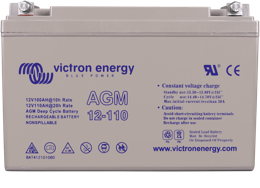
House battery
The house battery stores power for the boat’s electrical system. Sailing yachts typically have long intervals between battery recharges and the house battery should have a generous capacity.
For a house battery you can choose from two types: lead-acid and lithium. There are various reasons to favour one over the other. Here are a few common ones:
|
|

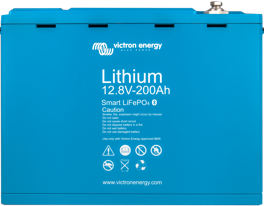
House battery
The house battery stores power for the boat’s electrical system. Sailing yachts typically have long intervals between battery recharges and the house battery should have a generous capacity.
For a house battery you can choose from two types: lead-acid and lithium. There are various reasons to favour one over the other. Here are a few common ones:
|
|

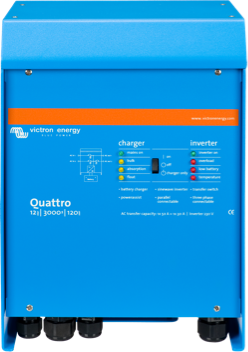
Inverter/Charger
The inverter/charger is the heart of the system. In the marina, it charges the batteries from shore power. While sailing it inverts the energy from the boat’s battery into AC power for household devices. The switch from charging to inverting and from inverting to charging is seamless.
- Victron inverter/chargers come with a handful of outstanding features:
- PowerControl: automatically manage battery charging to prevent an overload of the generator or shore power.
- PowerAssist: uses the battery as a buffer to assist the shore power during peak power demand.
- Perfect power: even sensitive devices run flawlessly on the pure sine wave power.
- High peak-power: use motorised equipment without overheating.
- Low self consumption.
For this power profile we would recommend:
We would recommend our Multiplus-II inverter/charger. If you have a generator on board you’ll need a Quattro inverter/charger, which has an extra input (shore power and generator).
We strongly recommend 24 Volts for new boats. The higher voltage is simply a better choice when it comes to meeting the power demands of a modern sailing yacht. If your boat’s system is based on 12 Volts, select a 12 Volts unit instead.

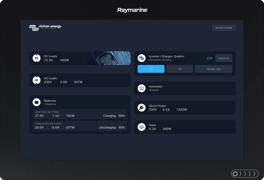
MFD GX Integration
The Victron integration between our GX range and several leading Multi Functional Display manufacturer brands enables you to easily connect an MDF to the heart of your power system such as the Cerbo GX, or the GX enabled Multiplus-II GX. Once connected you can easily monitor and control your boat’s power system, right on your Glass Bridge.

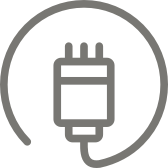
Shore Power
In the marina, the boat will be connected to shore power. Shore power recharges the batteries. It can also be used for maintenance and to run large AC loads.
Often shore power is limited in how much power you can draw, i.e. just 10 Amps. Berths with higher ratings might not always be available. Victron inverter/chargers allow you set a maximum shore power current. Now you can charge your batteries and turn on any equipment without blowing a fuse.
Sometimes shore power is less than perfect. You might run into voltage drops if you’re at the far end of the harbour. There could also be power surges, which could harm sensitive equipment on board. Victron’s inverter/chargers smooth out these problems and turn bad power into perfect power.

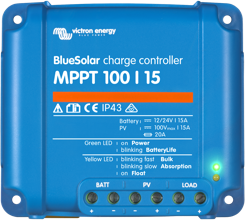
Solar charger
A solar charger- also called MPPT controller, harvests the power from the solar panels to charge the house battery. Solar chargers have the same charging cycles as our regular, fully automatic, battery chargers. When your boat is moored without shore spower, solar power is a great way to keep the batteries charged.
In a marine environment, the performance of solar panels changes constantly. Victron’s solar controllers use ultra fast maximum power point tracking to squeeze up to 30% more power out of your panels.
The rating of the solar charger is defined by the size of the solar panel. For solar panels of less than 150W or less, choose a 75/10 charger. If your solar panel produces between 150 and 220W, pick a 75/15 instead.
See our Solar Calculator to size the solar panels and select a MPPT charger
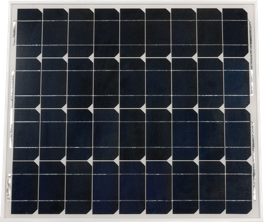
Solar panel
More and more sailing yachts area equipped with solar panels. After all, they extend the autonomy range without the noise of a diesel engine and… for free. Victron offers a wide range of small, highly efficient, solar panels that are just perfect for boats.
See our Solar Calculator to size the solar panels

Starter Battery
The starter battery is needed to start your boat’s engine. These batteries are different from house batteries and engineered to deal with a large discharge current. The starter battery should always be ready to go. It’s best to isolate the important starter battery from all other electrical circuits on board, so it cannot be accidentally drained of power.

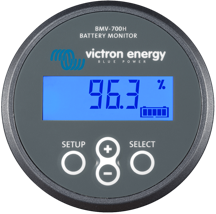
VE.Direct Bluetooth Smart dongle
The Bluetooth dongle enables you to use the VictronConnect app with VE.Direct enabled devices (without Bluetooth built-in). With the app you can have real-time insight and full control, and you can access all VE.Direct enabled devices such as the smaller VE.Direct inverters, the BMV 70x series battery monitors or MPPT solar controllers.

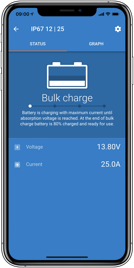
VictronConnect
All Victron products on your boat can be monitored and controlled from the palm of your hand. Just connect the VictronConnect App via Bluetooth and you’ll have direct access to values like battery voltage and current. You can also turn devices on or off, as well as change their settings.
See what the VictronConnect app can do

VRM - Victron Remote Management
Monitor and manage
Monitor and manage your Victron Energy systems from anywhere and catch potential issues early by setting alerts and alarms. With VRM you are always in perfect control from wherever you are.
VRM works with a GX-device such as the Cerbo GX with internet connection, the GlobalLink 520 or GSM LTE 4-g for smaller systems.
Monitor
Monitor the battery state of charge, power consumption, power harvest from solar, generator and mains in real-time. Optimise the energy harvest and usage with history graphs and detailed analytical reports. Catch potential issues early by setting alerts and follow up on alarms to prevent definitive system failure.
Manage
Easily control the shore power input current limit, switch on the inverter, (auto)start/stop generators or even set quiet periods to avoid starting the generator in the middle of the night. With VRM you can change any setting, follow up on alarms, perform diagnostic checks and resolve challenges from wherever you are.
See all our GX-devices
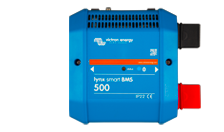
Lynx Smart BMS
The Lynx Smart BMS is a dedicated Battery Management System for Victron Lithium Smart Batteries (for non Victron Lithium batteries, see below). There are multiple BMS-es available for our Smart Lithium series of batteries, and the Lynx Smart is the most feature rich and complete option. Its main features are:
- Built-in 500A contactor, used as a fallback safety mechanism and also suitable as a remote controllable main systems switch.
- Battery monitor, indicating state of charge percentage and more data.
- Pre-alarm signal: provide a warning before the system shuts down due to -for example- a low cell.
- Bluetooth for use with our VictronConnect App, for setup and monitoring.
- Local and remote monitoring using a Victron GX device, for example the Cerbo GX.
Battery Management System
The dedicated battery management system (BMS) protects Victron Lithium Smart batteries against deep discharges, overcharging and high temperatures. When critical values are exceeded, the BMS acts immediately: loads are disconnected physically in case of a deep discharge and charging is stopped when there is a risk of overcharging. High temperatures trigger an immediate end to both charging and discharging.
Battery monitoring
Battery monitoring is built into the Lynx Smart BMS; no separate battery monitor is needed. With Bluetooth the battery bank can be monitored with VictronConnect, when connected to a GX-device, also with VRM, our remote monitoring solution.
Lynx Distribution system
This product is part of the modular Lynx busbar system that also provides the Lynx Distributor which is a modular DC busbar containing 4 DC fuses and monitors their status in VictronConnect and VRM and other DC connections to handle distribution, fusing, battery monitoring and/or Lithium battery management.
Non Victron Lithium batteries
The Lynx busbar system can also be used for DC distribution and monitoring of non-Victron Lithium batteries. In that case, replace the Lynx Smart BMS with the Lynx Shunt VE.Can for monitoring of any other battery. See all Lynx modules

The professionals choice:
See which product is recommended for this system example
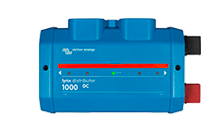
Lynx Distributor
The Lynx Distributor is a modular DC busbar, with locations for four DC fuses. It will monitor the status of each fuse, and indicate its condition with a LED on the front. When connected to a Lynx Smart BMS or Lynx Shunt, the status of the fuses will be visible in VictronConnect and VRM (when the Lynx Smart BMS is connected to a GX-device).
Multiple Lynx Distributors can be used to connect all the DC-loads and charge sources on one side of the BMS, on the other side, a Lynx Power In (without fuses) or another Lynx Distributor (with fuses) can be used to connect the battery bank to the modular busbar.
Lynx Distribution system
This product is part of the modular Lynx busbar system that also provides the Lynx Smart BMS, a dedicated Battery Management System for Victron Lithium Smart Batteries (for non Victron Lithium batteries, use the Lynx Shunt).
See all Lynx modules
The professionals choice:
See which product is recommended for this system examplePower consumption will vary from yacht to yacht and from owner to owner, even on sailing yachts. Here are two examples - with a normal and a heavier daily energy consumption - of what an Optimal Energy plan for a sailing yacht could look like. Please note that many more factors come into play when designing and installing your optimal solution: your Victron Professional will gladly help you with that.
MultiPlus magic: small generator, big power.
An expert view: lithium or AGM aboard?
Get your wiring right with Wiring Unlimited
Show more
See your system performance right from your Glass bridge
See all our Marine products and more configurations.
Real-time insight and complete control with our VictronConnect app
Find your local dealer
Our well established global network of local Victron Professionals is dedicated to help find an optimal solution for your challenge.
Count on our worldwide service
At Victron we find it essential that customers are serviced and supported quickly and competently. This is why our global network of Victron Professionals pack the highest level of technical know-how and are committed to deliver repairs as fast as possible.
So you can start or continue your journey, wherever you’re headed.
